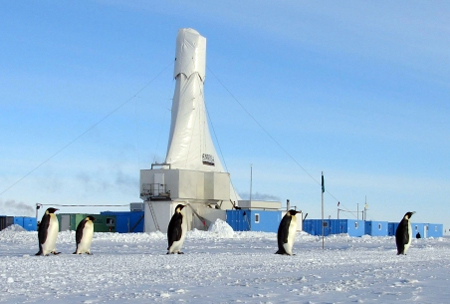|
That's a wrapANDRILL hits target depth for second straight yearPosted January 10, 2008
More Information
There’s an old cliché that goes: You don’t know where you’re going until you know where you’ve been. That’s something of a mantra for the scientists, drillers and support staff who returned to McMurdo Station this season to extract a second sediment core for the ANtarctic geological DRILLing (ANDRILL) Program. The researchers on ANDRILL are after a geologic record of the relatively recent past that will tell them how ice sheets, ice shelves and sea ice responded to warming and cooling events millions of years ago — a scenario many scientists believe we will return to in the next century. That information is important to help predict sea level rise, should melting occur as the planet heats up. And for the second straight season, the ANDRILL crew enjoyed unprecedented success, extracting a sediment core 1,138.54 meters below the seafloor with a recovery rate of 98 percent. Only last year’s operation on the McMurdo Ice Shelf went deeper, with a depth of 1,285 meters below the seafloor. It also enjoyed a similar core recovery rate as this season. While the two field seasons for this $30 million International Polar Year project had different goals and mostly different personnel, the lessons learned the first year dovetailed into a fairly smooth second effort that required a more intense pace as the operation moved to the sea ice in McMurdo Sound. (See related story: ANDRILL returns to Antarctica.) It is Richard Levy’s job as staff scientist for ANDRILL to ensure everything fell into place, from planning the operation at the project’s headquarters at the University of Nebraska-Lincoln to troubleshooting problems while on the Ice. “Things went much more smoothly [this season],” said Levy in mid-December, just a day before the last members of the team departed McMurdo Station for points north. “Last year, everyone was learning the ropes. … Some of the facilities that we struggled to get up and running last year, obviously weren’t an issue this year. We had people who knew exactly what we were after.” Levy was one of the few among the 80-strong ANDRILL contingent who had worked both field seasons, serving as a link between the chief scientists from last and this year. In addition, he’s intimately involved with defining the science proposals and developing the site surveys for future drilling projects. “There is a lot of work to do, for sure, but it keeps me interested because I’m jumping and changing between things all the time,” Levy said. The results this year, while hardly predictable or easy, were expected considering the level of detail involved in planning the operation, which involves four nations — the United States, New Zealand, Italy and Germany. Still, there was excitement that ANDRILL hit its target date so accurately. “We’re thrilled to get the record of time that we did recover,” Levy said. “We were targeting the transition from a couple of periods of warmth in the early to mid-Miocene, 17 to 14 million years ago.” Said co-chief scientist David Harwood, “It's everything we hoped for. Combine the drill hole we recovered last year with this one, from a time period right below it, and it’s more than 2 kilometers of geological history.” The ANDRILL scientists believe the development of the modern Antarctic ice sheets occurred during the middle Miocene. It’s a period that witnessed a change from a warm climate approximately 17 million years ago to the onset of a major cooling event about 3 million years later, and the formation of a quasi-permanent ice sheet on East Antarctica. “It’s phenomenal what we’ve recovered,” said Harwood, with the University of Nebraska-Lincoln and ANDRILL’s U.S. principal investigator. “There’s a lot of diversity in the core, indeed more than we can digest right now. It will take some time to fully resolve the paleoenvironmental and dynamic paleoclimate information in the core.” The scientists are still tight-lipped about their findings, as there is still much they need to analyze. Nor do they want to trump the scientific papers they hope to publish, particularly in prestigious journals like Science and Nature. |
"News about the USAP, the Ice, and the People"



For USAP Participants |
For The Public |
For Researchers and EducatorsContact UsNational Science FoundationOffice of Polar Programs Geosciences Directorate 2415 Eisenhower Avenue, Suite W7100 Alexandria, VA 22314 Sign up for the NSF Office of Polar Programs newsletter and events. Feedback Form |



